SEO optimization guide for BigCommerce(Tips, Apps & Plugins)
BigCommerce is one of the most widely used and well-known eCommerce tech creation tools today, and many retailers use it to enter the realm of the internet by creating online shops and selling to anyone who visits them. BigCommerce is a SaaS (Software as a Service) platform that has benefited from SEO services, and BigCommerce SEO tips are sure to help your business succeed as well.
But it is BigCommerce’s SEO optimization techniques that have drawn the attention of the entire audience, consumers, and clients (including additional apps and plugins). Your website can attract users and be more easily discoverable for search engines due to these keywords and SEO-related posts.
Keywords, definitions, website names, blog entries, and brands are examples of information that needs to be filled in. In this article, we’ll learn more about SEO optimization for BigCommerce.
Getting started - The fundamentals of SEO

Search Engine Optimization (SEO) is one of the most important marketing and sale techniques for any company, especially online businesses. Nowadays, online company owners rely on social media campaigns and paid advertising, which is an ongoing financial investment mechanism in which you must keep spending to keep the ad running. On the other hand, SEO is a type of science art that aids in the growth of your website to far higher rankings than any other instrument.
When it comes to SEO, it’s a journey, not a destination
Patience and perseverance would be crucial to your progress. It all boils down to how much time and dedication you’re able to bring forward. And if you achieve a high rating, keep in mind that search engines change, and you’ll need to adjust your tactics accordingly.
Shoppers should be the focus, not search engines
Don’t get sucked into writing keyword-heavy material just to please the search engines. We’ll discuss search engines a lot, but the key priority is to adapt your web store and its material to your target audience. Focusing on your customer, creating quality content that they find interesting, and sharing the content with them is the foundation of good SEO.
Search engines just want to provide their customers with the most appropriate information based on their search queries. You’re really on your way to ranking well if you have a fantastic shopping experience.
Content is King
Regardless of how clever and complex search engines have been, one thing remains constant: content. Content is original, one-of-a-kind material that you produce and post to your website. Anything from product descriptions and blog entries to videos and photos to the About Us page will be used.
When selling online, content not only acts as a tool for search engines to understand your website, but also serves as a connection between you and your customers. Great material never sleeps, never takes a rest, and is adored by search engines and customers.
Incorporate design into your SEO plan
We’ve seen many clients put a lot of emphasis on architecture and then want to incorporate SEO later. However, SEO should be a top priority in the creation of your online shop.
Strong SEO needs effective content curation, best accessibility standards, and proper information infrastructure. If you neglect these (especially during the design phase), you can end up spending countless hours later retrofitting an existing site to help communicate with search engines and shoppers.
Prioritize the most relevant pages
It’s critical to choose the most popular sites while optimizing the website. Every company is different, but the most visited sites are typically your category pages, product pages, and home page. If you’re unsure which website to prioritize, use Google Analytics or Ahrefs Site Explorer to see which sites get the most traffic.
Developing an SEO Strategy
1. Keyword Research
Either of two things will happen if you get this part wrong:
-
You’ll try to rank with keywords that are too difficult to rank with, and you’ll never get to page one.
-
You’ll score with keywords that don’t get any traffic or don’t lead to sales.
Neither of these scenarios is optimal, which is why ecommerce keyword research is crucial: it ensures you target keywords that are relatively easy to rank with, words that have a reasonable search volume, and good conversion rates.
Many keyword tactics may not be carbon clones of one another, depending on the vertical in which your company operates. Often within the same industry, businesses will have product distinctions that set their brand apart from the competition. If you don’t have the right terms and combinations of words on your landing and product sites, search engine crawlers won’t find you.
If you’re having trouble coming up with industry terms or phrases that you believe would provide the best outcomes, consider this from a consumer’s perspective: What does a customer look for while looking for your product or service?
A few points to bear in mind when assembling a keyword list are:
-
Brand terms: words or phrases that are exclusive to your business.
-
Product terms: What your product is or does
-
Competitor terms: What is the competition up to?
-
Alternative product descriptions: Can the product be referred to in other ways by customers?
-
Audience terms: Any language that is exclusive to your target market
Some terms and phrases can be more useful than others, so it’s never a bad idea to compile a long list of keywords to cover all your bases. Since different terms reflect different degrees of concern and purpose, it’s best to use a mix of short- and long-tail keywords.
2. Site architecture
It’s time to put what you’ve learned about the best keywords to target to use. The design or arrangement of an eCommerce platform, refers to how you organize your navigation, category pages, and product pages. It’s all about putting the latest, most appropriate information in front of consumers and reducing the number of clicks required to find it.
Great site structure follows two “golden rules”:
-
Make it flexible and easy.
-
It can take no longer than three clicks to get from one page to another.
-
Build extremely important page URLs and subdirectories using keyword research.
For an eCommerce site, this is an example of BAD site architecture.
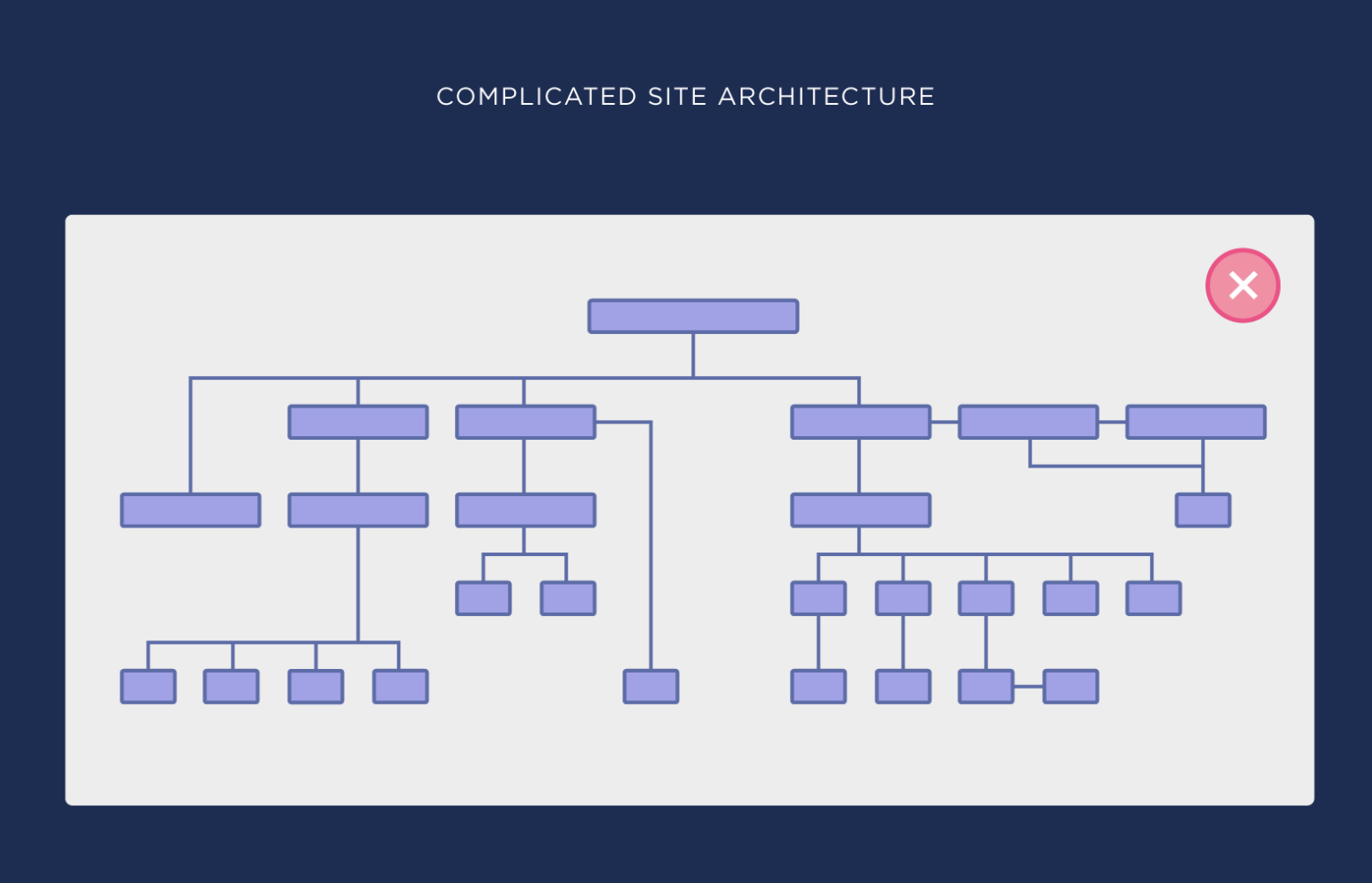
Your home page is usually the most authoritative page on your website. Internal connections between pages on your web transfer some of the “authority” from one page to the next. This was formerly known as PageRank, but Google no longer uses the word.
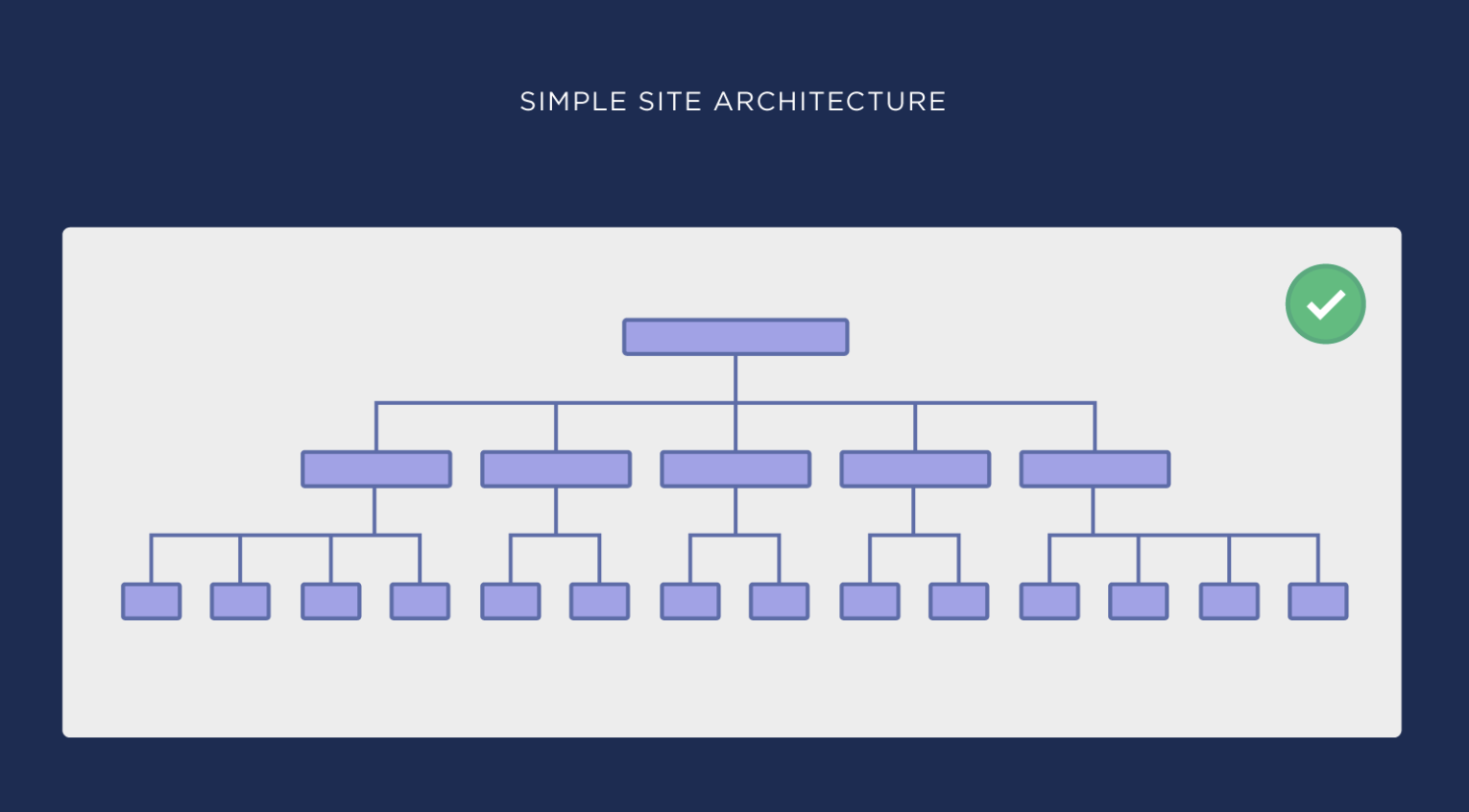
All of your main category links, perhaps some of your best product pages, should be linked from your home page. Correct navigation and internal linking mean that certain pages get the most authority from your home page and, as a result, have a higher chance of ranking well in a quest.
Google will have difficulty locating and indexing any of your websites if your website is a labyrinth of pages. Therefore, you should avoid this major mistake.
Note: If your site’s structure isn’t perfect, don’t start pushing pages around until you’ve spoken with an SEO specialist. Without weakening your SEO, they will help you merge pages, enhance internal linking, and redirect old pages to new pages.
3. On-page Optimization
It’s just about making sure the keywords are in the right positions regarding on-page SEO for eCommerce. It’s just a way for Google to understand what the website is about.
On-page SEO is crucial because it aids your visibility in other Search Engine Results Page (SERP) functionality.

Without a doubt, your category pages are the most crucial pages to rank. If they’re found on Google, they’ll have instant access to all of the products in that genre. You should use your targeted keyword in the following places to better customize these pages:
-
In the web address: It’s easy to use the primary keyword in the URL (and to make the URL readable and friendly) to boost search rankings. This is particularly the case for websites that compete in more crowded market segments. Organic rankings are influenced by a variety of factors; however, optimized URLs are another way to achieve an advantage over the rivals and attract more traffic.
-
In the tag for the title (H1): The keyword should be as similar to the beginning of the title tag, or H1 tag, as possible.
-
In the body of the text: This is where things start to get a bit more complicated. The majority of category pages skip the introduction and head right to the goods, which is bad for Google. Aim for a 300-word introduction with your keyword mentioned at least 2-3 times. (However, don’t cram it in; let it flow and seem natural.)
-
In the image’s alt text: Since Google can’t read videos, it relies on alt text to figure out what they’re for. This offers you another place on the website to use your keyword and a chance to appear in Google picture results.
Pro tip You can recruit anyone on Fiverr or upload a proposal to 99 Designs if you’re not good at design and need banners designed for you.
In the meta information: Although it hasn’t been shown that using the keyword in your metadata (the gray text that appears in your search listings) has a direct effect on rankings, it has been shown to increase click-through rate been shown to boost rankings.
Another aspect you need to pay special attention to is the product page. Follow the same steps as you did with your category pages, with two exceptions:
-
No banners (since you have product images).
-
Write 1,000 words instead of 300 words (at least on your 10 top sellers).
Long-form material of at least 2,000 words is popular on Google’s top pages. Since Google is mainly a testing tool, it believes that a website with a lot of detail has a higher chance of containing the response a searcher is looking for.
4. Technical SEO
It’s not just about keywords when it comes to SEO. There’s also a technological aspect to consider, such as web speed, user interface, device friendliness, and working connections.
It’s just about giving your customers the best possible experience. So, how can you conduct a professional SEO audit and boost your eCommerce SEO?
For reference, check out Ahref’s 16-step audit for an extensive guide on all the technical materials. But, for the sake of clarity and speed, I’ve condensed it:
- Crawlability and Browsability: BigCommerce generates SEO-friendly URLs for each of your store’s pages automatically, but you can customize how they’re formatted in your Store Settings. If you’re not sure whether or not to customize them, we recommend that you leave them as is (Short).
BigCommerce also makes certain that each specific page has only one URL, ensuring that you are not penalized for redundant content. When you rename a commodity, the auto-populated URL changes to match the new name, and the old URL is redirected to the new one. This avoids 404 errors for both customers and search engines (broken link).
Search engines can tell whether you’ve changed or transferred pages on your blog thanks to automatic redirects and rewrites. You may also set 301 redirects manually, which is useful if you’ve migrated from another site or need to redirect old pages after removing material.
- HTTPS and SSL certificate: Google revealed in 2014 that HTTPS would be a factor in their search ranking algorithms. Google made a drive with Chrome 68 to mark any site that doesn’t use HTTPS as “not safe.”
While HTTPS is a minor ranking factor, the label “not safe” may have a negative effect on your store’s customer experience. For stores on any plan, BigCommerce provides a free SSL certificate, enabling you to unlock sitewide HTTPS.
-
Mobile-user friendly: Your website, now more than ever, must be mobile-friendly. Google recently revealed that they have begun transitioning to a “mobile-first” index, so it’s important to be prepared as soon as possible.
-
Site speed: According to Google, the acceptability rate for eCommerce websites is two seconds. That should serve as a guideline for you. There are several other advantages of speeding up the website, including increased conversions, improved user interface, and fewer empty carts.
BigCommerce’ve also teamed up with Akamai to make Akamai Image Manager available to all stores that use the Stencil style. No matter what system you’re using, Akamai Image Manager will automatically customize the images for the optimal viewing experience.
5. Local SEO
While local SEO isn’t for everybody, whether you have a physical store or just want more local site traffic will help. Google My Business is a cool feature that helps you enter your company’s information into Google’s servers.
This solves a few things, but the most important is that it helps your company appear in local search results. You will display details such as your website address, hours of service, photographs, and ratings, among other things. However, if you want to be found in local searches, you’ll need some local citations.
Backlinks from various local sources, such as television agencies, magazines, press releases, and other local media, are local citations. Citations are crucial for local SEO because they demonstrate to Google that you are well-known in your region. This is also applicable to overseas SEO. If your web is hosted in the United States and you want to place higher in Australia search results, you’ll need more connections from Australian pages.
6. Content Marketing
Content promotion not only boosts your traffic and, as a result, your revenue, but it also makes it possible to create connections to your blog and raise your domain authority.
It’s a lot easier to create links to high-quality blog material than to build links to a product or category listing. But, how do you go about doing it? I recommend reading this guide, which will take you through everything from choosing the right keywords and topics to posting, supporting, and linking to your material.
7. Link Building
There are two rating criteria that Google values over all others…
-
Content
-
Links
Backlinks to your website from other websites with high domain authority boost your rankings better than any other ranking element. It’s a bit more complex and time-consuming than just making a website change because they’re called off-page SEO. To get those connections, you’ll need to partner with other bloggers and website owners.
If the connection comes from a resource page, contact them as you would ordinarily. If it’s from a site’s navigation, call out and see if you can be added to the list to take the position of the other user — they may have worked out an arrangement where the linker gives the linker gifts or a fee or something.
See how you can form a partnership with them! When it comes to commissions, you should seriously consider launching a partner scheme to help you increase your revenue and SEO.
Broken link building, also known as “link building by repairing the internet,” is one of the most powerful and simple link-building strategies. You use a plugin like this to look for broken connections on websites in your niche.
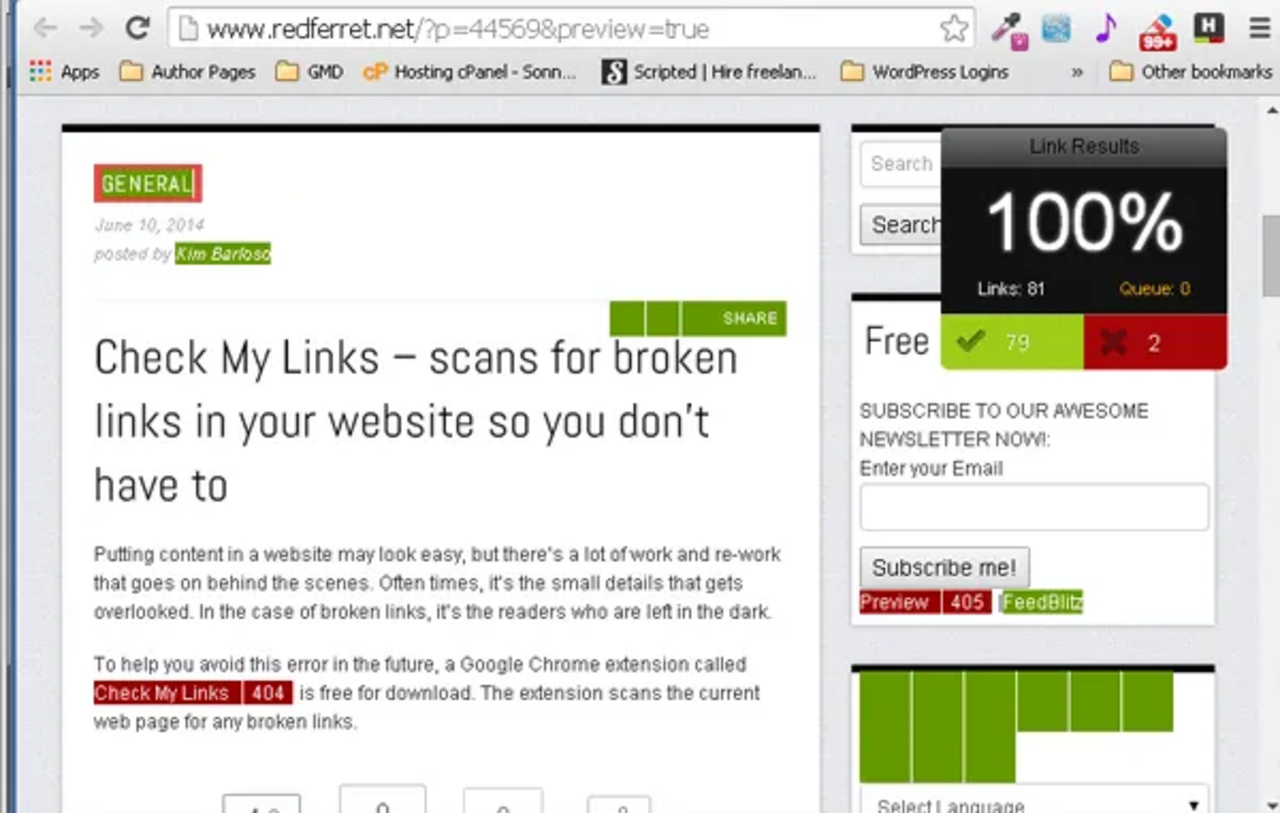
8. Measure and Control SEO results
Have you ever asked, “How do I know if my SEO attempts are working?” SEO isn’t as straightforward as PPC; you can’t measure ROI after a single day of ad spending. You have two options for keeping track of the rankings:
- Monitor them with an SEO tool like Ahrefs: You may use Ahrefs’ built-in rank monitoring function to be alerted if your ranks rise or fall. Indeed, they’ve recently improved this functionality to include much more valuable data, such as comparing your success to that of your competitors and seeing your total search visibility! What you’re aiming for is a general improvement in the rankings for your targeted keywords over time, even though it’s just a slight one.
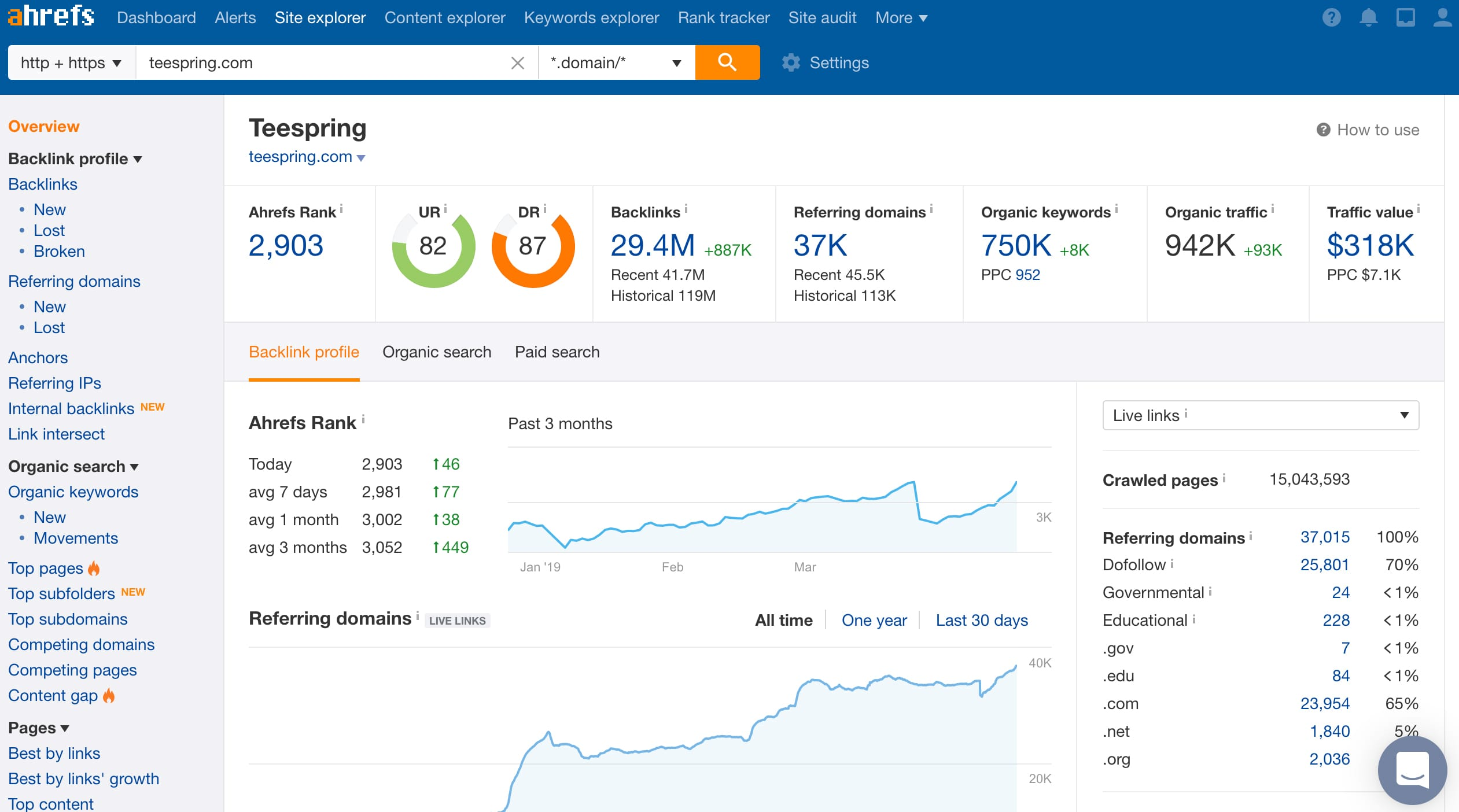
- In your analytics account, build an SEO dashboard: You’ll know where you stand until you’ve identified yourself; if you’re not using Ahrefs, make a list of your current location so you can map it over time. You’re asking for small rises once more. Going from page 5 to page 2 is a strong indication that you’re doing everything well and that your success will soon be rewarded.
Tracking and Measuring Methods
For all of the time and money that goes into improving your SEO, you’ll want to make sure that your commitment is worthwhile, particularly if you’ve hired skilled assistance. We’ll go into the metrics reports that come standard with your store and where you can get more support if you need it.
1. Google Tools
To begin collecting the required data, you’ll need to add your store to an analytics software like Google Analytics, Clicky, or Matomo. Since it’s free, strong, and gathers data from the world’s most famous search engine: Google, Google Analytics is a popular option.
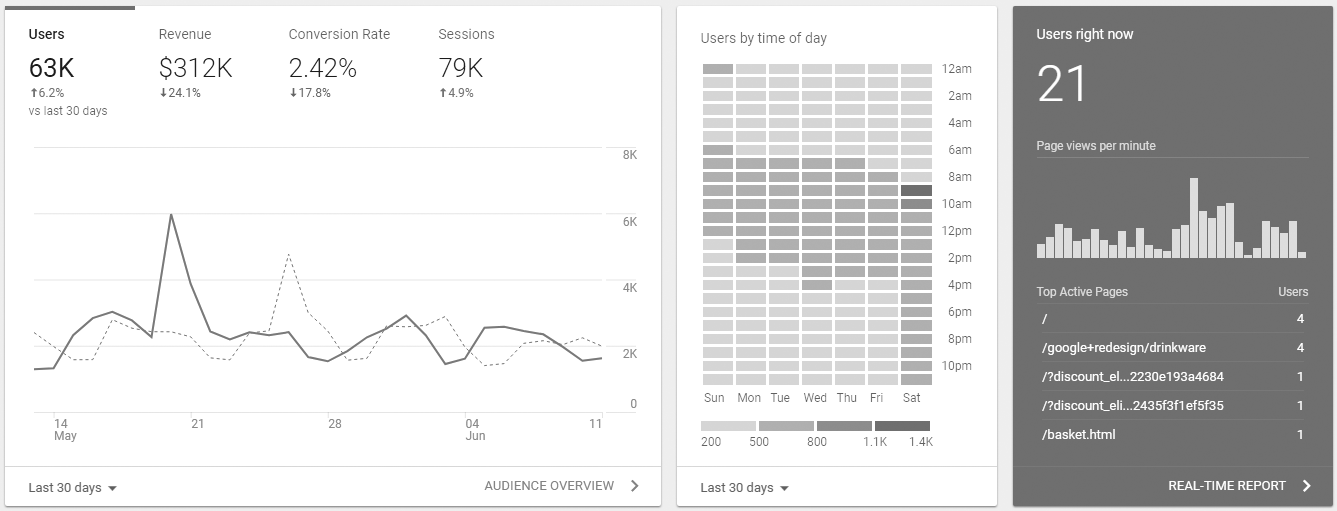
Both small and big online companies will benefit from Google Analytics. Google Analytics will show you how Google sees your web store, how customers interact with it through search engines, what keywords are the most profitable, and more.
-
Set up Google Analytics — Take the time to set up Google Analytics and eCommerce monitoring to learn how Google sees the blog, how users find it and other useful information. You will learn about your visitors’ trip through your platform and what they translate into purchases by allowing eCommerce monitoring and improved eCommerce tracking.
-
Sync Google Search Console data to Google Analytics — This is a bit more advanced, but syncing Google Search Console data to Google Analytics enables you to directly import data from Google Search Console. The data consists of landing pages, computer information, search requests, and even country information. Having all of this knowledge in one place makes data analysis more usable and effective.
2. KPIs
Depending on your priorities and the type of company you’re in, you can assess success in an SEO campaign in various ways. Although there are many data points to consider when evaluating the effectiveness of your SEO campaign, we’ll be concentrating on the following:
-
Keyword Rankings
-
Links (backlinks)
-
Page Speed
-
Organic Traffic
-
Click-through Rate
-
Exit Rate and Bounce Rate
-
Per Session Pages
3. Keyword Rankings
We spoke about how important it is to choose the best keywords for your target audience and optimize for long tail keywords, which are usually longer and more detailed. The success of your SEO campaign can be determined by how well you perform with them in search engines. The higher your rating for the keywords and phrases you want to hit, the better.
Naturally, you’ll score well with keywords like your company name, but don’t be disappointed if others don’t. Any of the keywords will face stiff competition, necessitating additional effort. The on-page and off-page optimization efforts can improve long-term efficiency. If they consistently underperform, it might be time to reevaluate them and either exclude them from the list or turn them into a long-tail keyword or expression.
You should check your rankings at least once a week, if not every day. Sudden drops may indicate an issue with your storefront that needs to be fixed right away. If you see slight fluctuations, don’t be alarmed. Variations are common and anticipated when search engines are constantly upgrading their algorithms to produce the best results for their customers.
4. Backlinks
Backlinks of high quality earn your site reputation, and the more you have, the more valuable you are to search engines. It’s also worth noting that you’ll want to keep track of the domains that generate new ties. Links from previously linked domains would carry less weight than links from new domains. New ties indicate that the content you’re producing is resonating with your target audience.
We suggest using a platform like SEMrush’s Backlink Audit, Ahref’s Site Explorer, Moz’s Link Explorer, or Majestic to perform a full audit of your backlink profile. These apps will search the ties for you automatically, making finding positive and poor links a breeze. You just need to use one of these apps, but you can also manually search your connection profile using Google Analytics.
5. Organic Traffic
Organic traffic is the most straightforward way to calculate the direct effect of SEO efforts. One of the key aims of any SEO strategy is to improve the brand’s popularity in search results. Both visits to your blog from search engines like Google, Yahoo!, and Bing are referred to as organic traffic. It’s worth noting that this excludes traffic from paying channels such as Google Ads.
At least once a month, take a look at the organic search traffic. Whether you’re regularly creating content or investing in a marketing strategy, you can check in on it at least once a week to see how things are going. Don’t be alarmed if you don’t see any growth or, worse, a downward trend.
6. Click-through Rate
Another KPI to keep track of is the organic click-through rate (CTR). The number of people “clicked through” to your website after finding it in search results is known as your CTR. E.g., if ten people saw your result but only one of them clicked it to go to that website, your CTR would be 10%.
This KPI is one of the most accurate metrics of how well the title tags and meta descriptions catch the attention of search engine users. It’s important to remember that CTR and keyword rankings are inextricably linked. Improving one will aid in the improvement of the other. According to research, pages with a better than average click-through rate will improve their ranking.
When you click on a tab, you’ll see the keywords that brought you there. It’s difficult to say what constitutes a “right” organic CTR because it depends on various variables such as the business you’re in, the keywords you’re using, and much more. Instead, we suggest focusing on the most important pages first, followed by low CTR but high rankings for their target keywords.
7. Bounce Rate

When someone comes to your website and immediately leaves without taking any action or visiting the rest of your pages, this is known as a bounce. The percentage of all sessions on your site where users visited just one page, as described by Google, is your bounce rate.
A low bounce rate indicates that travelers find a reason to stay and that your search result satisfies their needs. This may mean that the content you’re producing and the things you’re selling reach the right people. On the other hand, a high bounce rate could indicate that your content isn’t engaging enough or that your call to actions (CTA) are unclear.
It’s important to remember that a high bounce rate isn’t necessarily a bad thing. Bounce ratings on blog posts and other informative sites, for example, are normally high since visitors usually quit after reading the material. To pull users further into your web, it’s a smart idea to include links to similar material in your blog posts and product pages. If you see that your homepage has a high bounce rate, it’s a sign that it needs more work.
A high exit rate, like a high bounce rate, isn’t necessarily a bad thing. Some sites, such as the Thank You for Your Order page or the Contact Us page, are intended to be exit pages. If you find that your non-exit pages have a high exit rate, you can look into it and make changes. For example, a high exit rate on a landing page intended to push traffic further into your site may indicate that the call to action (CTA) was unclear or even absent.
Apps & Plugins to help your SEO Strategy
1. FaveSEO

FavSEO allows shop owners to edit, review, and refine the titles and meta descriptions of all brands, categories, and sites from a single location.
Store owners will use Google Webmaster Tools to find new keyword options, upload a sitemap, and log keyword rankings in Google after linking.
Disclaimer: Before making any modifications or using the bulk editor, we firmly advise you to make a backup of your entire title and meta explanations (if any).
FavSEO Audit’s features include:
-
Manage and edit the titles and descriptions for all of the site’s pages.
-
Update meta title, lists, pages, and blogs of your brands in bulk.
-
Look for fresh keyword openings.
-
Submit your sitemap to Google
Price: $19.95/month
2. ProSEOTracker
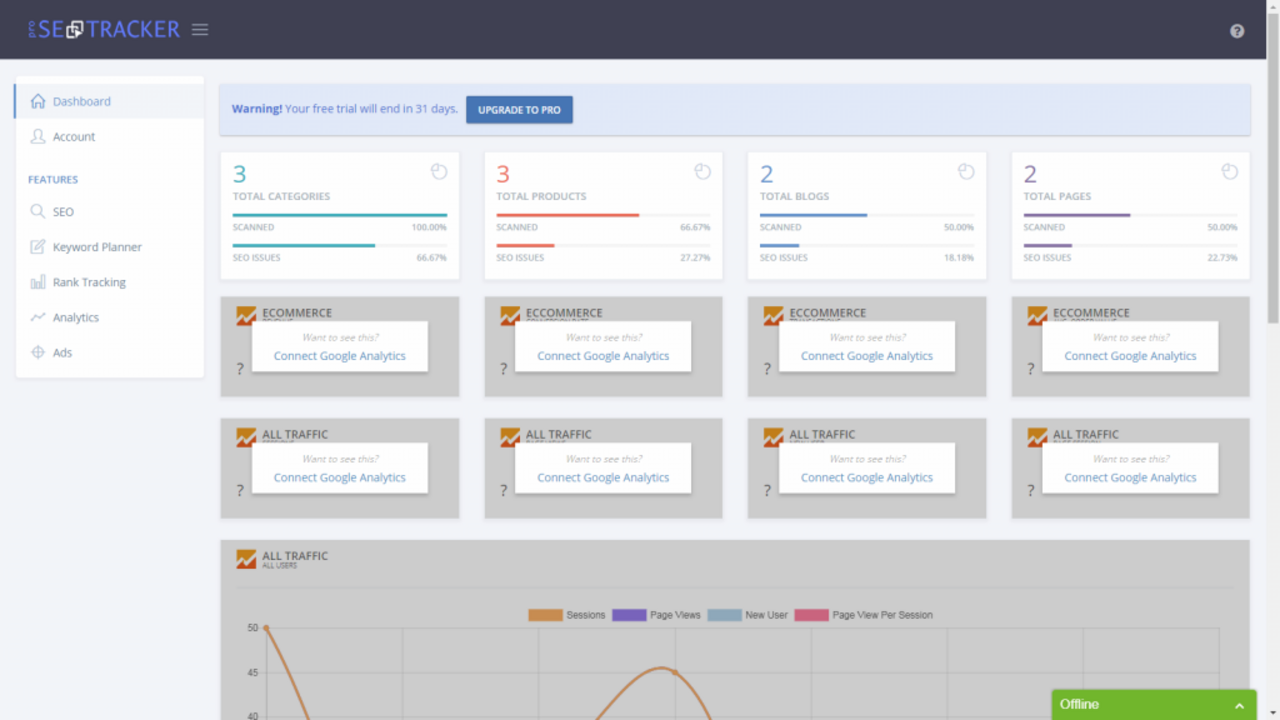
ProSEOTracker is a new all-in-one BigCommerce software that will help you improve the SEO efficacy of your shop and make it easier to find you on Google, Bing, Pinterest, and other popular search engines.
App features:
-
Update your store’s metadata to improve on-page SEO
-
Specify keywords to check for SEO issues and quickly fix them
-
Research new keywords for your site through Keyword Planner
-
Provide data on your SEO’s performance position in Google search results
-
Submit your website’s sitemap to leading search engines to increase online traffic.
Price: $16.95/month
3. ReloadSEO
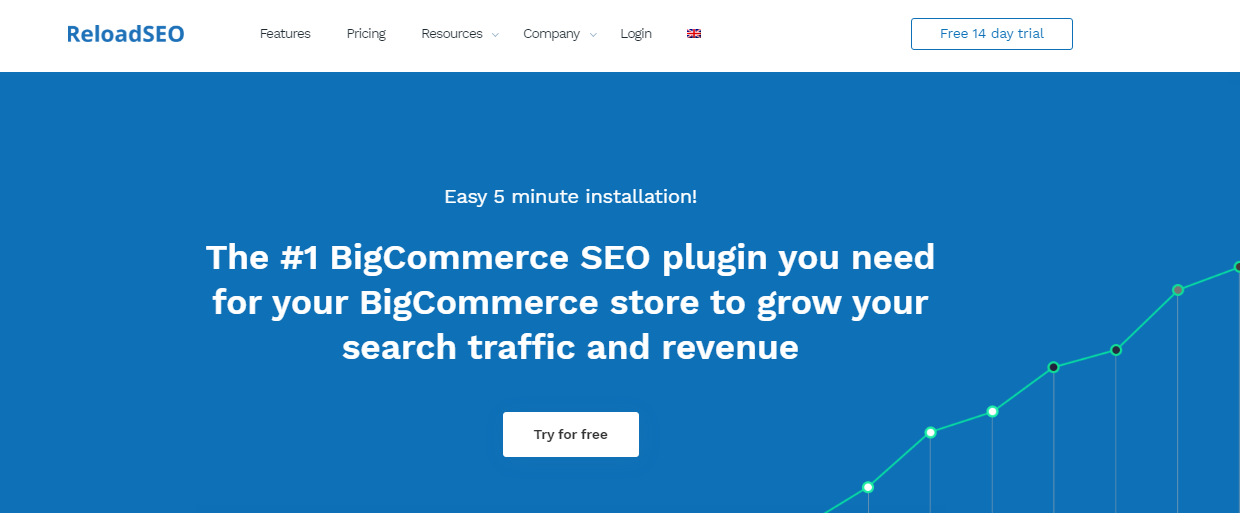
ReloadSEO provides you with all of the resources you’ll need to improve the performance of your BigCommerce shop. You can customize your brands, categories, and pages for on-page causes, study keywords, log keywords, crawl your shop, and analyze backlinks with BigCommerce SEO plugin.
You can use the Reload SEO dashboard to find out which pages, keywords, and areas of your website need to be tailored for search engines, such as:
-
Position tracking
-
Find out how to increase from keywords
-
Create content for both users and search engines.
Price: from $59/month
4. SEO Rich Snippets

Rich Snippets build Google-Compliant, JSON-LD Structured Data on your BigCommerce Pages by installing custom scripts into your Script Manager (sorry, just Stencil themes). The majority of the data comes from your Store and Product records, but you can customize it more to get the best out of Google Rich Snippets.
Price: $22/month
5. Schema Markup by Schema App

For BigCommerce, Schema App has the most comprehensive and reliable schema.org JSON-LD markup for BigCommerce, allowing you to increase click-throughs and conversions. This means Google knows just what you’re offering and can help you attract more customers. It fits every style and optimizes the following:
-
Products (and all options)
-
Ratings and Reviews
-
Articles or Blogs
Schema App for BigCommerce combines with Schema App software to refine your other store content, allowing you to optimize your static sites (homepage, contact us, services, about us, locations, etc.).
6. Shero
If your BigCommerce site isn’t as visible as you’d want it to be, or if you’re thinking of moving to BigCommerce to boost your rankings, an SEO audit from Shero may help. Shero is able to offer a detailed SEO analysis and strategy by doing a deliberate and extensively recorded evaluation of every part of the website:
-
Accessibility, descriptions, and meta content
-
Structure and content on the site
-
Compatibility and site architecture
-
Redirects and friendly URLs
-
Error detection
-
Google Analytics
-
Performance and Speed
-
UX and design
…and a lot more.
Conclusion
You must learn BigCommerce SEO today if you expect your platform to receive hundreds of thousands, if not hundreds of thousands, of monthly visitors.
Hundreds of extra sales can be produced by a simple SEO campaign. It also doesn’t have to take you years to do. With any of your shop’s main keywords, you’ll start to list on the first list — maybe sometimes in the top three performance. It’s a no-brainer, actually.





